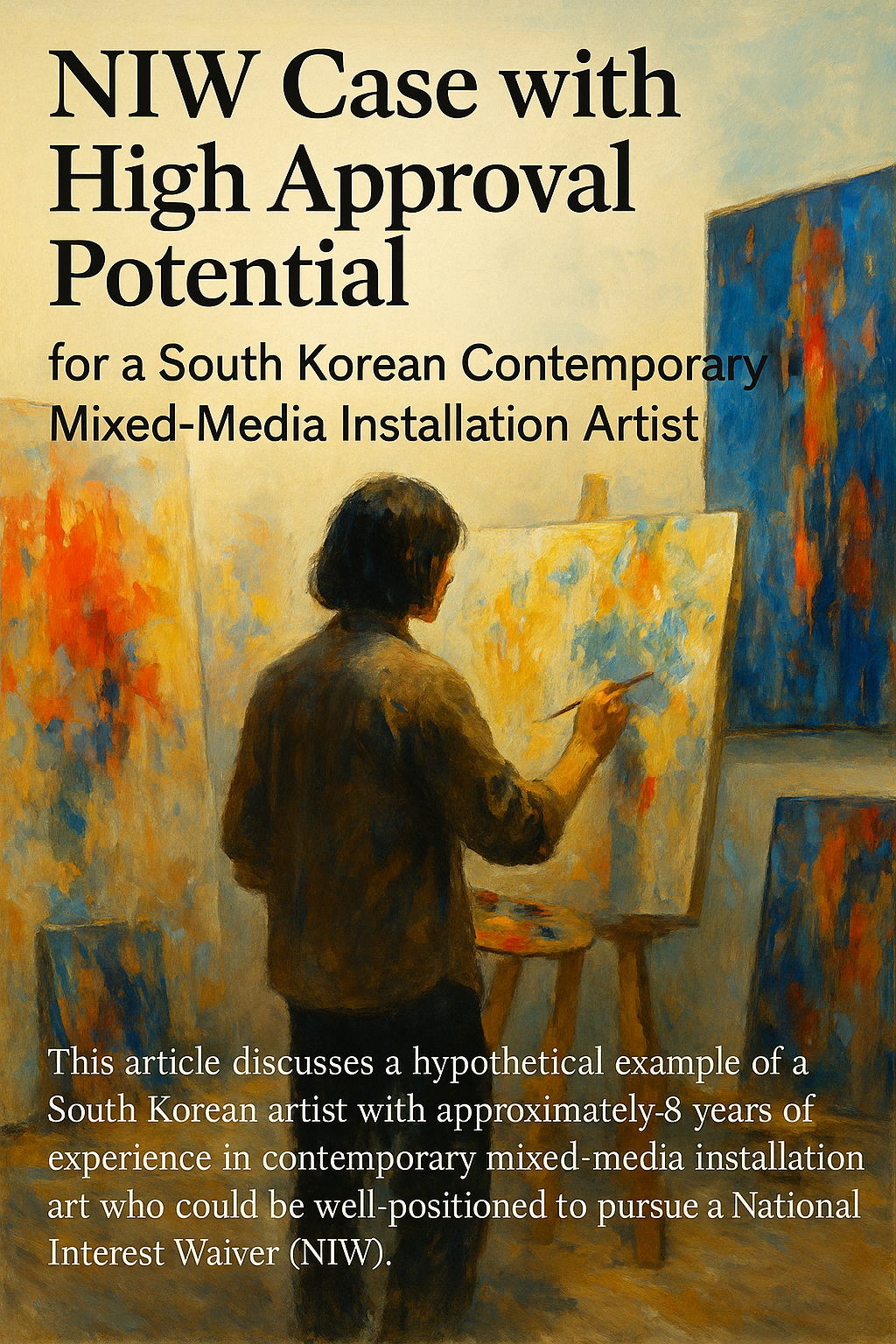A Strong NIW Case for Visual Artists: A Hypothetical Example in Installation Art

Today, we explore a hypothetical case of a contemporary
mixed-media installation artist from South Korea who may be
well-positioned to pursue a U.S. green card through the
National Interest Waiver (NIW) program.
This example illustrates how even those in non-STEM
fields—particularly fine arts—can present a compelling case when
backed by the right combination of career achievements and
forward-looking contributions to U.S. society.
The artist in this example has approximately eight years of experience working in mixed-media installation art, focusing on themes such as environmental issues, urbanization, and human disconnection in modern life. With a portfolio that includes three solo exhibitions and nine group shows—both domestic and international—as well as participation in two global art fairs, the artist has developed a strong record of professional activity. One of their notable works, addressing the theme of ecological regeneration, was awarded a special jury prize at a Korean international environmental art biennale.
What makes this artist's NIW case potentially strong is the alignment between their artistic themes and social discourse currently relevant in the United States. Public art, socially engaged art, and community-based creative practices are highly valued in the U.S. as means to foster inclusion, activate public space, and promote cultural dialogue. An artist who addresses such concerns through installation and mixed-media work could realistically claim their proposed endeavor holds “substantial merit and national importance”—the first of the three NIW requirements.
Additionally, the artist in this example is planning to expand their practice to the U.S. by participating in an artist-in-residence program in New York and engaging in collaboration with local galleries. Such concrete plans, backed by previous international exposure, help satisfy the second NIW requirement: that the applicant is “well positioned to advance the proposed endeavor.” The case becomes even stronger when the applicant can show letters of interest, invitations, or prior collaborative experience with U.S.-based art institutions.
Looking ahead, this artist intends to develop public art installations in collaboration with U.S. communities and lead educational workshops exploring the intersection of environment and visual culture. These proposed contributions not only align with current cultural policy priorities—such as public engagement, community revitalization, and equity in the arts—but also help meet the third NIW requirement: that, on balance, waiving the labor certification would benefit the United States.
While the outcome of any NIW case depends on the totality of evidence and case strategy, this example highlights that visual artists—particularly those with a strong body of work and a socially engaged vision—may have a viable path to permanent residency in the U.S.
At our office, we have assisted professionals from a wide range of fields, including arts, technology, healthcare, and public policy. If you are an artist wondering whether NIW may be a path for you, feel free to contact us at askus@junlawfirm.com or call 847-660-4233 / 317-701-2768 for a consultation.
related articles
case study
- Experienced Immigration Attorney for Indiana and Surrounding States Key Lessons from a National Interest Waiver Appeal
- Experienced Immigration Attorney in Indiana A Lesson in National Interest Waiver Case Dismissals
- Immigration Attorney in Indiana Insights on a National Interest Waiver Appeal for Forensic Accounting Services
- Immigration Attorney in Indiana National Interest Waiver (NIW) Denial Based on Exceptional Ability Without an Advanced Degree
- NIW Proposed Endeavor Medical Doctor National Importance
- NIW Success Story - Architect
- Why Was This Accountants NIW denied
- NIW Success Story: Pakistani Civil Engineer Paving the Way for Seismic Safety in the U.S.
- NIW Success Story: Mr. Lee – A Battery Recycling Innovator Advancing Renewable Energy in the U.S.
- NIW Success Story: A Professional Specializing In New Drug Development
Testimonials
Artists and NIW
- Artists and NIW
- NIW for Artists Required for Higher Standard of Review
- Art as a National Asset: Crafting a Compelling NIW Case for Artists
- A Strong NIW Case for Visual Artists: A Hypothetical Example in Installation Art
- National Interest Waiver (NIW) for Visual Artists
- Can My Art Really Matter to American Society?